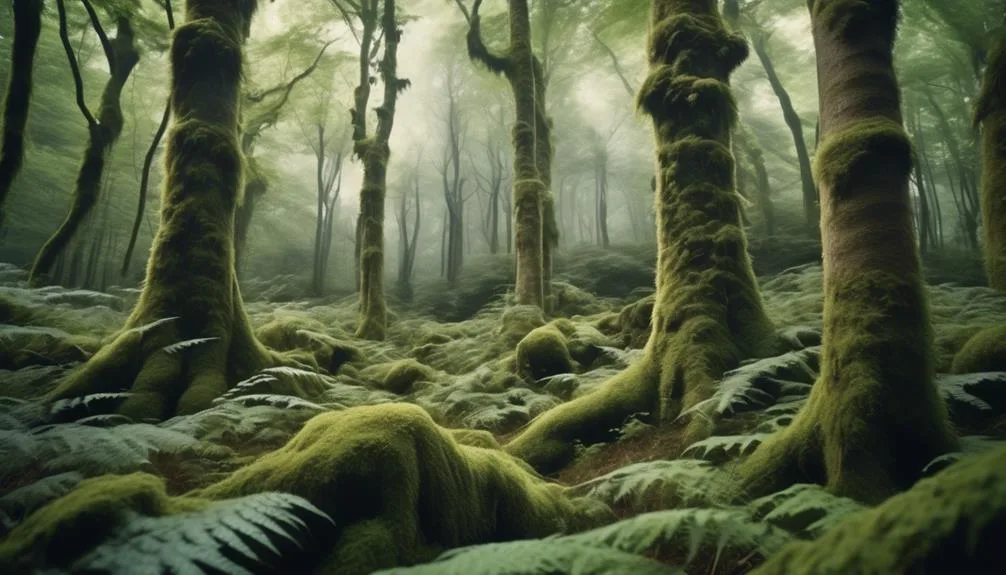The eastern United States is home to thriving wild beech trees, found in specific regions like temperate forests, coastal areas, and mountainous regions.
If you're lucky enough to stumble upon one of these majestic trees, you'll be treated to a sight of smooth gray bark against lush greenery.
Exploring their secret locations can lead you through some of the most beautiful landscapes nature has to offer, making it a rewarding adventure.
Eastern United States
In the eastern United States, you can easily find wild beech trees flourishing in the lush forests and woodlands of the region. Identifying these majestic trees can be quite simple.
Look for smooth, silvery-gray bark and shiny, oval-shaped leaves with fine teeth along the edges. The distinctive pale, papery bark of younger beech trees also sets them apart from other species.
As for conservation, beech trees face threats from diseases and climate change. Efforts to conserve these trees include monitoring for beech bark disease, promoting genetic diversity, and protecting their natural habitats.
Temperate Forests
Amidst the diverse landscapes of the world, temperate forests offer a rich tapestry of flora and fauna waiting to be explored.
These forests, found in regions with distinct seasons and moderate climates, are biodiversity hotspots teeming with life. The towering canopies of deciduous trees such as oaks, maples, and beeches create a mesmerizing display of colors in the fall, while coniferous species like pines and spruces provide year-round greenery.
The forest floor is often carpeted with an array of wildflowers, ferns, and mosses, adding to the enchanting allure of these woodlands. Wildlife abounds in temperate forests, with an assortment of mammals, birds, and insects calling these ecosystems home.
Exploring the winding trails and serene groves of these forests offers a chance to witness nature's splendor up close and immerse yourself in the wonders of these captivating environments.
Specific National Parks
Nestled within the expanse of temperate forests are specific national parks that showcase the breathtaking beauty and ecological diversity of these woodlands.
When it comes to beech tree preservation and biodiversity, Great Smoky Mountains National Park stands out. Home to a rich variety of beech trees, this park provides a haven for their preservation. The deep green leaves of the American beech and the striking copper-colored bark of the European beech create a mesmerizing sight.
Shenandoah National Park is another gem for beech enthusiasts. Its diverse habitats harbor an array of beech tree species, including the distinctive weeping beech. The intricate patterns of beech leaves and the soothing rustle of their branches in the wind make these national parks a must-visit for anyone interested in the preservation and biodiversity of beech trees.
Coastal Areas
Along the coastal areas, the salty sea breeze carries the faint scent of wild beech trees, adding a unique charm to the landscape. Coastal beech ecosystems thrive in these areas, creating picturesque scenes with their smooth, silvery bark and vibrant green leaves.
These ecosystems are vital for various flora and fauna, providing habitats for diverse species. However, coastal beech trees face challenges such as salt spray, coastal erosion, and changing climate conditions. Beech tree conservation efforts are crucial in these regions to protect these majestic trees and their ecosystems.
Through conservation initiatives, researchers and environmentalists aim to preserve the natural beauty of coastal beech areas while ensuring the sustainability of these ecosystems for future generations to enjoy. Visiting these coastal areas not only offers breathtaking views but also raises awareness about the importance of preserving these unique and delicate ecosystems.
Mountainous Regions
In the rugged expanse of mountainous regions, wild beech trees stand as sentinels of resilience and natural beauty, shaping the landscape with their sturdy trunks and lush foliage.
When exploring these majestic areas, keep an eye out for wild beech trees by looking for their distinctive features: smooth gray bark, oval-shaped leaves with fine teeth, and small, prickly beechnuts.
As you traverse the rugged terrain, take note of ongoing conservation efforts aimed at preserving these ancient giants. Organizations are working diligently to protect wild beech trees from threats such as climate change and invasive species.
Conclusion
Next time you venture into the great outdoors, keep an eye out for wild beech trees. Whether in the Eastern United States, temperate forests, national parks, coastal areas, or mountainous regions, these majestic trees with smooth gray bark and vibrant green leaves are a captivating sight.
Happy exploring, and may your encounters with nature's wonders continue to inspire your journey.

My interest in trees started when I first saw the giant sequoias in Yosemite.
I was a teenager then, and I remember thinking, “I need to learn more about this.”
That moment stuck with me.
A few years later, I went on to study forestry at Michigan Tech.
Since graduating, I’ve worked in a mix of hands-on tree care and community education.
I’ve spent over ten years helping people understand how to plant, maintain, and protect the trees in their neighborhoods.
I don’t see trees as just part of the landscape.
They are living things that make a real difference in our daily lives.
